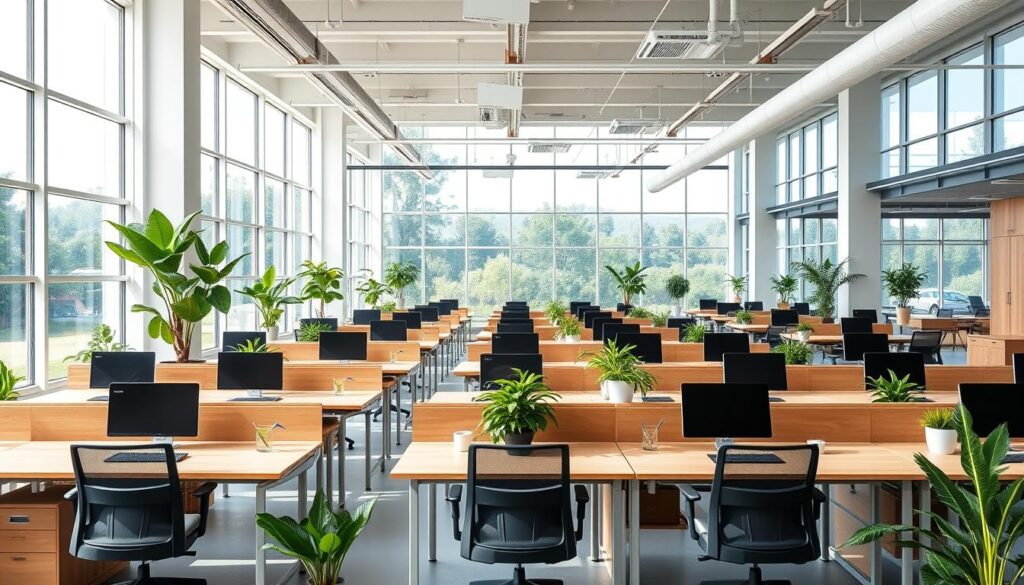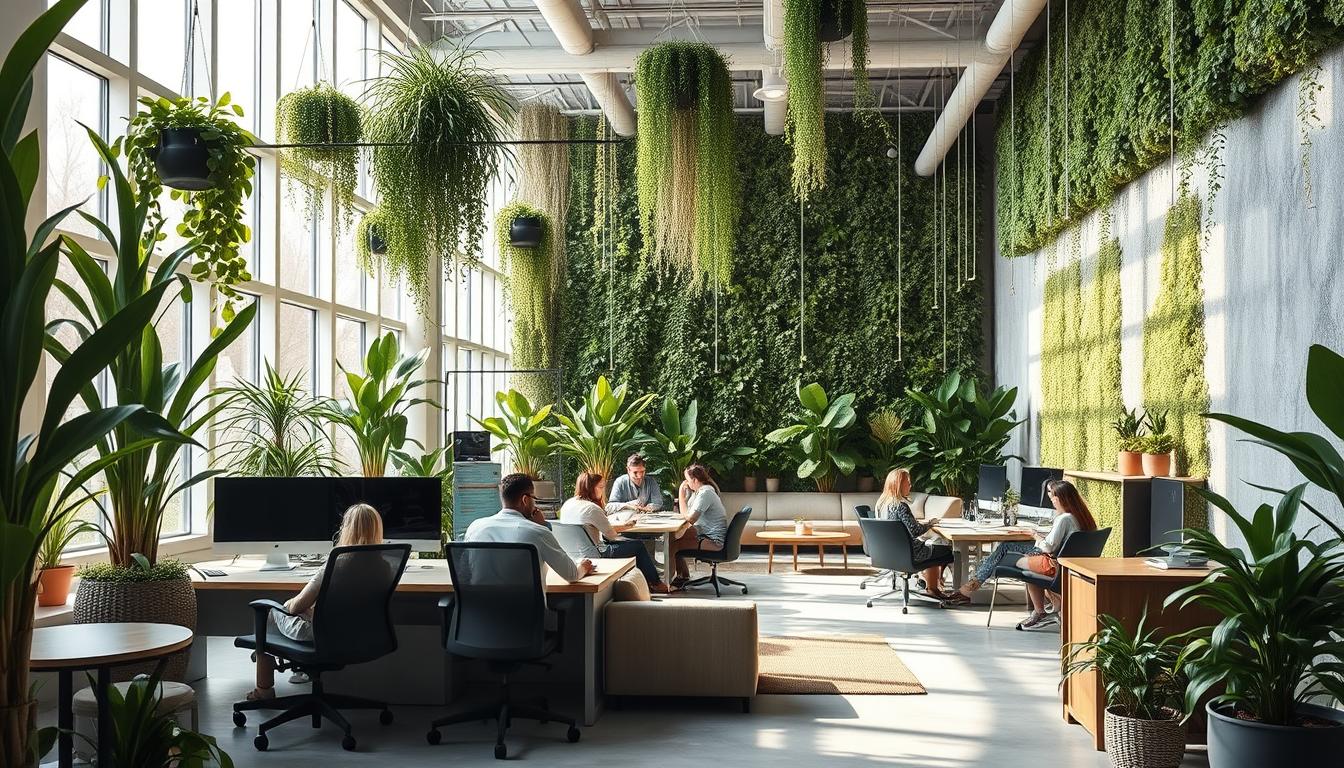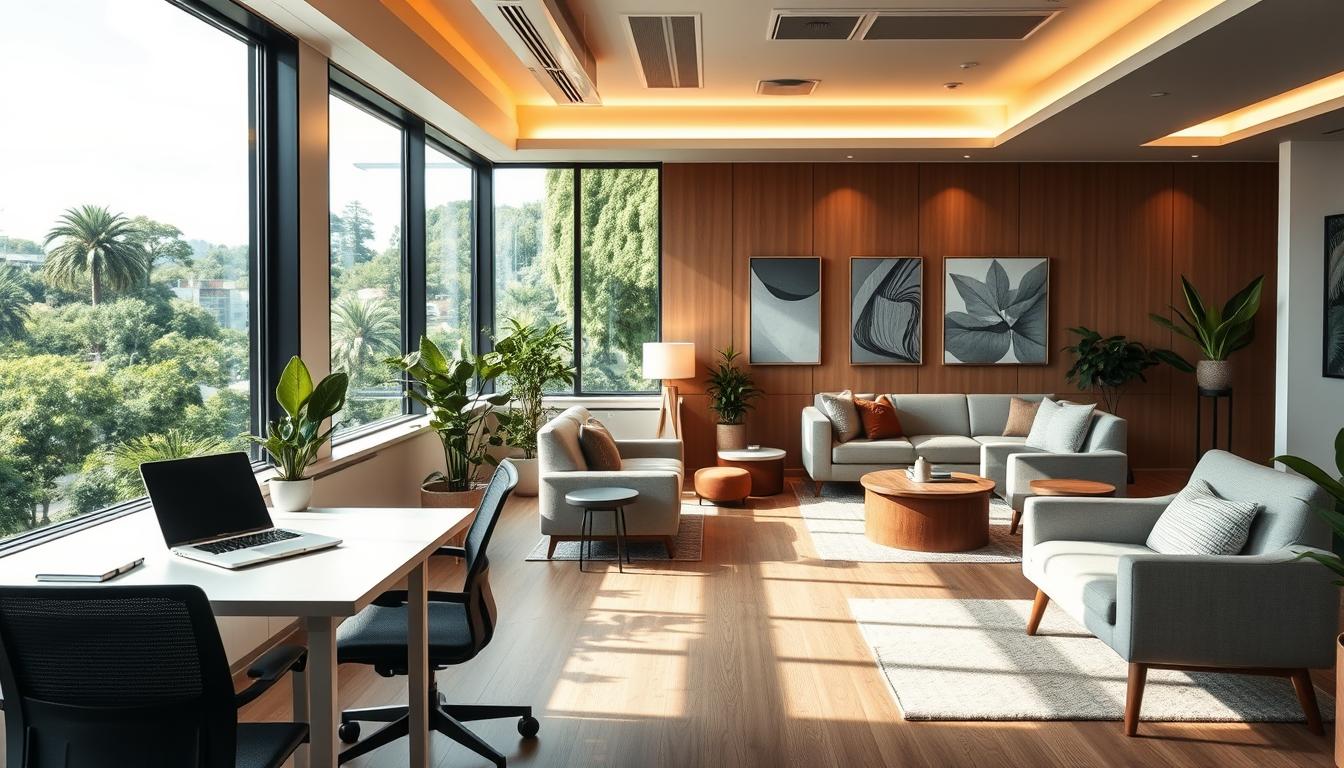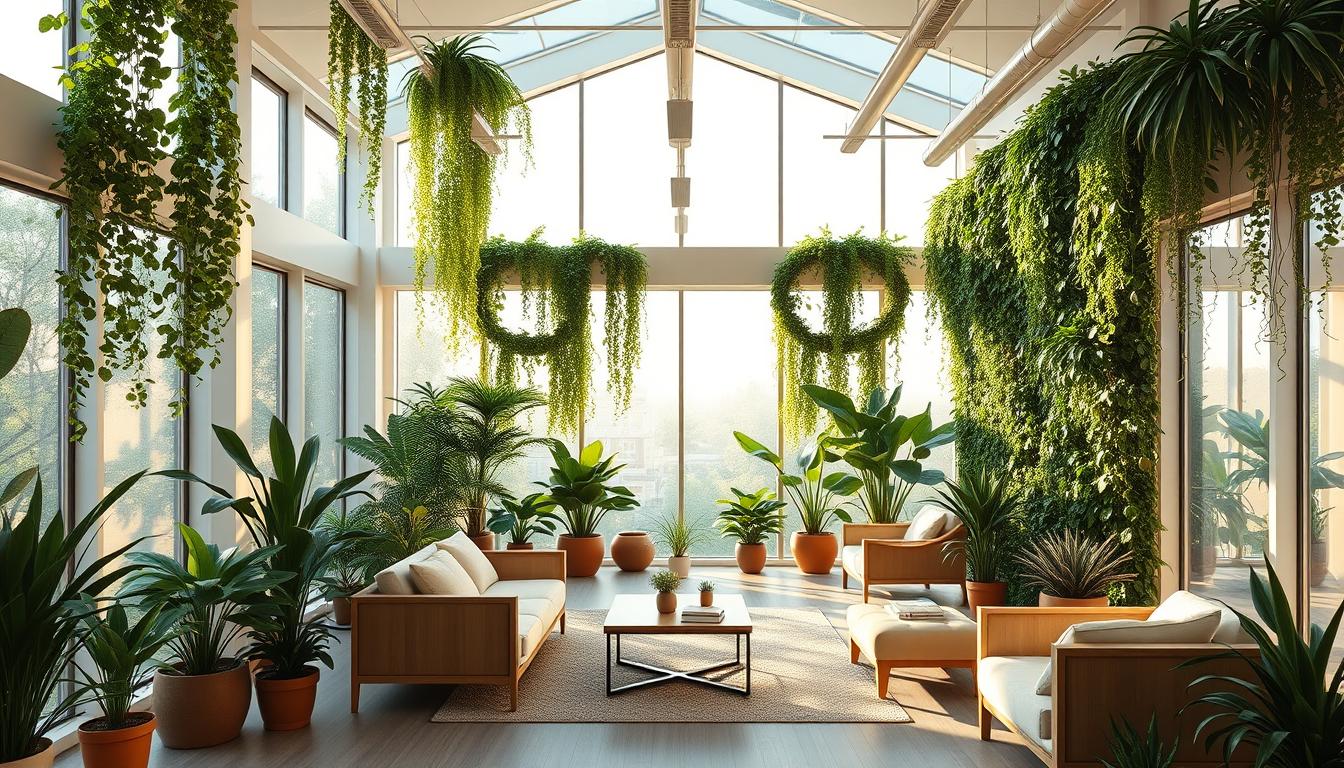Open-plan offices are more popular than ever today. They encourage team work and easy talk between workers. Adding adaptive greenery to these spaces can make the office better and healthier for everyone. Using the ideas of biophilic design, companies can bring nature inside. This not only looks good but helps people feel better at work. Plants play a big role in this change. They improve the air and lower stress. This article will show how adaptive greenery can change the way we work for the better.
Understanding Open-Plan Offices
Open plan offices are a modern twist in workplace design. They break down walls like cubicles. This setup helps coworkers work together easily. It also lets communication flow freely, making teams stronger and ideas spread faster.
The benefits of this design are not just about looks. It lets more natural light spread, which makes employees feel better and more energetic. These offices can change easily as companies grow or change, helping them stay innovative.
Open-plan offices also save money by using space better. This cuts costs and helps workers feel like they’re part of a community. The move towards open plan offices shows a commitment to making workspaces that are effective and welcoming.

The Importance of Biophilic Design
Biophilic design is key in making environments that connect us to nature. This is vital for improving workplace wellness. Adding nature, like plants, to places we work not only looks good but also helps our mental health. Studies prove that green spaces boost mood and help us work better.
Creating a Connection with Nature
To really connect with nature at work, we need to bring biophilic design into play. This means:
- Incorporating living plants and natural materials.
- Utilizing natural light and views of outdoor landscapes.
- Implementing natural patterns and textures in decor.
Adding these elements makes our workspaces not just pretty, but also comfortable. It helps lower stress and anxiety for everyone there.
Enhancing Employee Well-Being
Putting employee wellness first with biophilic design is great for our minds. Studies have found that plants can reduce stress hormones like cortisol. Research from Texas A&M University shows that people in green spaces are more creative and solve problems better. So, adding nature to where we work can make us all more focused and innovative.
Benefits of Adaptive Greenery in Open-Plan Offices
Open-plan offices with adaptive greenery offer big perks. They make the air better, help people get more done, and lower stress. Plants in the workplace mean happier and healthier employees.
Improving Air Quality
Plants make office air cleaner. They get rid of bad chemicals and add oxygen. This makes a healthy space to work. Better air means people can focus more and do better at their jobs.
Boosting Productivity and Focus
Studies show plants help make offices quieter and more peaceful. This helps people stay on task. With a calm place to work, teams can do more and better work.
Reducing Stress and Anxiety Levels
Greenery makes offices look and feel nicer, which helps cut down on stress. Research finds that plants make workers less anxious. Less stress means a happier place to work for everyone.
Choosing the Right Plants for Your Office
Choosing the right office plants means knowing your workspace’s specific needs. Light, upkeep, and style are important things to think about when picking plants. Low light plants are great for spots without much sunlight.
Best Indoor Plants for Low Light Environments
Choosing the best plants for shady areas can make your office look and feel better. It can also clean the air. Here are some top choices:
- Pothos: Known for its trailing vines and resilience, it adapts well to various light conditions.
- Snake Plant: This hardy plant requires minimal care and remains vibrant in dim lighting.
- Chinese Evergreen: Appreciated for its attractive foliage, it thrives in low light and humid environments.
Considerations for Plant Selection
When picking plants, think about their looks, health benefits, and how they fit in. Keep these points in mind:
- Growth habits: Select plants that complement your office layout and furniture.
- Aesthetic appeal: Choose varieties that contribute positively to the decor.
- Air-purifying qualities: Favor plants known for their ability to filter toxins from the air.
Effective Plant Placement Strategies
Placing plants smartly in open-plan offices can make the space better. By hanging plants and putting big plants on the floor, you make the office look good and work better. This setup not only looks nice but also helps with sound and keeps things private.
Utilizing Vertical Space with Hanging Plants
Hanging plants make the office look better and save space. You can hang them from the ceiling or shelves. This draws the eye up and makes the place feel bigger. It also means more room on the floor for people to move and get things done. Here are some ideas for hanging plants:
- Pick light plants like spider plants or pothos.
- Use macramé hangers for extra style.
- Hang plants on the wall for a cool garden vibe.
Creating Natural Barriers for Privacy
Plants can also help make private spots, perfect for focus. By placing tall plants like fiddle leaf figs or rubber plants wisely, you define work areas. This setup lowers noise and makes the space more comfortable. Here’s how to use plants as natural barriers:
- Put big plants around to mark individual work areas.
- Group small plants to make informal meeting places.
- Line pathways with plants to cut down on distractions.
Caring for Adaptive Greenery
Keeping plants in an office needs careful attention to help them do well. It’s important to water them on a schedule, make sure they get enough light, and clean them now and then. Doing these things can make your plants look great and improve the air in your office.
Maintenance Tips for Office Plants
Looking after office plants can be easy if you stick to a few key tips:
- Set up a regular watering schedule that suits each plant type.
- Make sure your plants get enough light. Move them if you have to.
- Clean the leaves to help them get more light for growing.
- Keep an eye out for bugs and deal with them quickly.
- Choose good soil that gives your plants the right nutrients.
Selecting Low-Maintenance Plant Options
Choosing plants that don’t need much care involves picking from many good options. Some great ones include:
- Snake Plant: It’s hardy and looks good, even in dim corners.
- Pothos: It doesn’t need much attention and cleans the air.
- ZZ Plant: It’s happy with little water and not much light.
- Spider Plant: It adapts easily and makes any space look better.
Adaptive Greenery in Open-Plan Offices Design Trends
The latest office design trends show how important adaptive greenery is. It makes modern offices look better. Adding plants to work areas has become more than just for looks. It helps workers feel good and do their jobs better. Living walls and vertical gardens are favorites, making the place pretty and the air clean.
Innovative designs use plants to make offices feel less stiff. These designs can show off plants in special ways. They help people relax and think of new ideas. Also, having green areas in open offices lets people take short breaks. This can lead to talking and sharing ideas easily and feeling less stressed.
More companies are choosing office designs that care for the environment. Adaptive greenery is now a key part of this. It makes the office look welcoming and creative. By bringing nature into the office, companies show they care about the planet and their employees. This makes workers happier with their jobs.
Incorporating Technology in Plant Care
Technology today makes taking care of plants easier and more efficient. In offices, tech can help keep plants healthy with little effort. Smart tools are key in making plant care simple and helping plants grow well.
Smart Watering Systems
Smart watering systems are a big step forward in caring for plants automatically. They give plants just the right water at the right times. With sensors, these systems avoid too much or too little water, so plants grow best. These systems help keep office plants healthy, whether they’re on their own or part of a bigger smart garden setup.
Monitoring Plants with Apps
Apps for plant care give users great ways to look after office plants. They let people watch moisture levels and remind them when to water plants. This means plants stay healthy in the office. Mobile tech lets workers keep their office green without it getting in the way of their work.
Maximizing Natural Light in Office Spaces
Making the most of natural light is key in making an office feel better and work better. By placing plants smartly, you can get more sunlight. This makes plants healthier and brightens up the entire office. A good mix of plants and light makes working spaces more enjoyable.
Positioning Plants for Optimal Light Access
To help your office plants get enough sunlight, try these tips:
- Place plants near windows or light sources for increased exposure.
- Utilize transparent partitions that do not block light passage.
- Group plants together to create a vibrant collection that benefits from shared light.
Using Mirrors and Reflective Surfaces
Adding mirrors and shiny surfaces can make your office brighter. Here’s how these items can help:
- Direct light towards darker areas, enhancing overall brightness.
- Create an illusion of depth and space, making the office feel more open.
- Serve as a stunning visual accent while simultaneously improving light distribution.
Creating Collaborative Spaces with Plants
In today’s offices, building a team spirit is key. Adding plants to group areas makes them look better and helps people bond. Plants draw in folks, encouraging them to talk and work together.
Utilizing Group Plant Displays
Adding plants in shared spots turns dull areas into lively gathering places. This move makes the office more inviting and boosts team work. Different plants add energy and make employees happier. This reminds everyone that work is also about relationships, not just tasks.
Enhancing Team Spirit with Shared Green Spaces
Green spaces in the office give teams a break and a new spot to meet or chill. They can be used for informal chats or brainstorming. Having plants around shows the company cares about its people. This makes working together easier, raising productivity and happiness at work.
Challenges of Maintaining Plants in Open Offices
Adding plants to open offices makes the space brighter. But, it also adds some challenges in taking care of them. To deal with these, having a good plan for allergy management and making sure plants get enough light and water is key.
Addressing Allergies and Sensitivities
Some plants can cause allergies, making it tough for certain employees. Picking the right plants helps avoid this. You can choose:
- Hypoallergenic plants, such as snake plants or spider plants, which produce fewer allergens
- Creating designated plant-free zones for individuals with sensitivities
- Educating staff about care practices to reduce allergens, such as regular dusting of foliage
Managing Water and Light Accessibility
It can be challenging to make sure each plant is well-cared for. To tackle this, you need a plan for effective watering and good light:
- Designating specific areas for plant watering to avoid spills and create a routine
- Using grow lights in areas with limited natural light to support plant health
- Investigating self-watering systems that provide plants with consistent moisture
Conclusion
Adding greenery to open-plan offices is a big step forward in designing workspaces. By bringing in plants thoughtfully, businesses can make their workers more productive and healthier. The benefits, like cleaner air and less stress, strongly support changing old office designs into lively, green spaces.
Using plants smartly in offices helps people feel closer to nature, which boosts teamwork and creativity. As mental health and productivity become more important to companies, the importance of greenery grows. Adopting this idea can make workplaces happier, healthier, and more efficient, helping the whole organization.
Workers do better in healthy, vibrant environments. Investing in plants improves the look and function of offices, making people happier and more connected. This shows how critical it is for companies to support green projects for better well-being and productivity at work.



